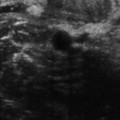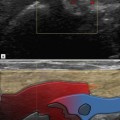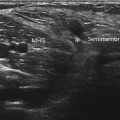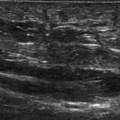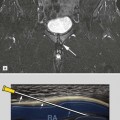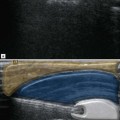Specific Intervention Techniques
Subacromial Subdeltoid Bursa Injection
Biceps Tendon Sheath Injection
Suprascapular Ganglion/Nerve Treatment
Sternoclavicular Joint Injection
Coracoacromial Ligament Division
Distal Radioulnar Joint Injection
Carpometacarpal and Scapho-Trapezio-Trapezoid Joint Infections
Extensor Compartment 1: De Quervain’s
Lateral Cutaneous Nerve of Thigh Block
Adductor Origin Pubic Symphysis
Aspiration of Paediatric Hip Effusions
Tensor Fasciae Latae/Iliotibial Band
Trochanteric and Gluteal Bursa Injection
Piriformis Syndrome and Ischiofemoral Impingement
Achilles and Peri-Achilles Intervention
Achilles Dry Needle Autologous Blood and Platelet-Rich Plasma Injection
Volume Injection/Tendon Stripping
Tibialis Posterior Tendon Sheath Injection
MID- AND FOREFOOT INTERVENTION
Shoulder Intervention
Subacromial Subdeltoid Bursa Injection
Technique
Ultrasound-guided injections are generally from a superolateral or anterior approach. A simple method is to place the probe in the same position as used to generate a coronal image of the cuff. From this position, the needle can approach either from above the probe or from below. For a right-handed operator, a left shoulder injection can be carried out by holding the needle in the right hand and the probe in the left hand, whilst the operator stands behind the seated patient. The reverse is true for the right shoulder. A needle approach from above has the advantage of not having the probe cable interfere with the needle (Fig. 30.1). An alternative is to place the probe axially in an anterior position until clear visualization of the supraspinatus tendon and subacromial subdeltoid bursa is obtained. The skin is punctured lateral to the probe and the needle directed towards the bursa (Fig. 30.2).

Figure 30.1 Superior approach to the subacromial subdeltoid bursa. For a right shoulder injection from posterior, the probe is held in the ultrasonologist’s right hand. This approach is free of interfering probe cables. It does require a minimum of dexterity with the left hand if the operator is right-handed.

Figure 30.2 Axial approach to the bursa. In this position, the needle can be held in the right hand, which right-handed operators may find more comfortable. The probe cable can be wrapped around the left hand to prevent interference with the needle.
The overlying deltoid should been seen to lift temporarily away from the bursa driven by the pressure of the injection. When the injection is finished the muscle/tendon should relax back into its normal location. If there is uncertainty regarding the needle position within the bursa, this distension/relaxation appearance can be reproduced by giving a pulse injection. The plunger is pressed firmly and the layers of the bursa should separate when plunger pressure ceases; the two layers of bursa should return together. If the needle tip is extrabursal, the tissue planes will separate on injection but will not recompress easily as the injected fluid is not free to flow away from the injection site. Another useful tip for larger bursae is to place the probe over a different part of the bursa and confirm that fluid is flowing freely into it from the point of injection.
The subacromial subdeltoid bursa is a large structure and can accommodate quite considerable volumes of fluid, although a total injection dose of more than 10 mL is usually not necessary. It is also useful to reexamine the bursal surface of the tendon following injection as the fluid introduced to the bursa may now demonstrate a bursal surface partial tear not previously appreciated.
Acromioclavicular Joint
If ACJ subluxation is present, the lateral aspect of the joint is open to an approach from the lateral side. If there is any joint effusion projected above the joint, this too can be accessed by a coronal approach from the lateral side.
The probe is held in the coronal plane directly above the joint and moved immediately until the joint is seen close to the lateral margin of the image. A point is marked on the patient’s skin lateral to the probe, representing the puncture point (Fig. 30.3).
If there is no malalignment or effusion, the joint is best injected in the sagittal plane. This view is obtained by placing the probe, initially, medial to the joint and identifying the bony reflective margin of the clavicle. The probe is then moved laterally until the bony reflection disappears, indicating that the probe is now positioned directly over the joint (Fig. 30.4). Further lateral movement brings the bony acromion into view. The probe is returned to overlie the joint either anteriorly or posteriorly and the needle is inserted at 90° to it in the sagittal plane. In this position it is easily seen entering into the joint. Reversing needle and transducer is equally effective. The ACJ is a rather small joint and is unlikely to accept more than 1–1.5 mL. It is therefore recommended that a low-volume syringe is used.

Figure 30.4 This approach to the ACJ is used if the joint is not particularly distended or there is little acromioclavicular offset. The joint is seen as an echo-poor space. There is excellent visualization of the needle as it is inserted parallel to the probe. A coronal approach to the ACJ is easier if there is joint widening, effusion or offset.
Glenohumeral Joint
Glenohumeral joint injection is indicated for patients undergoing MR arthrography, for local anaesthetic injection to diagnose indeterminate shoulder pain, to guide treatment of glenohumeral arthropathy and to distend the shoulder in patients with adhesive capsulitis. As most shoulder dislocations are anterior and the structures of interest also lie anteriorly, a posterior approach for MR arthrography is a good choice for reducing any extravasation or artifact, which may subsequently impede interpretation of the study.
The needle is most frequently introduced lateral to the ultrasound transducer and directed obliquely along a path to where the humeral head slopes towards the posterior labrum (Fig. 30.5). Once the skin is punctured, the needle should be directed in the same long axis as the probe to ensure it stays in-view and reaches the correct part of the joint. Alternatively, a medial puncture can be used and directed to a point lateral to the labrum, but generally there is less room to manoeuvre with this approach, unless there is an effusion. Care should be taken not to aim for the glenoid margin itself as a large labrum may displace the needle posteriorly and prevent accurate placement into the joint. The intraarticular position of the needle can be confirmed by injecting a small amount of local anaesthetic. If the needle is correctly positioned, the injected local anaesthetic will disappear into the joint and no resistance will be felt. The arthrographic material or an antiinflammatory cocktail may then be injected. In the early stages of the injection, distension of the posterior glenohumeral joint recess is not evident. Towards the end of the glenohumeral joint injection, if a sufficiently large volume of fluid has been instilled, the posterior recess of the glenohumeral joint begins to distend and the posterior capsule is seen displacing away from the humeral head. Colour-flow Doppler can also show the injectate flowing way from the needle tip.

Figure 30.5 Posterior approach to the glenohumeral joint with the patient leaning forward with their head resting comfortably on pillows. It is important not to puncture too far laterally as the curvature of the humeral head may force the needle medially and into the labrum. The target area in this case is the needle resting comfortably between humeral head and labrum.
Calcium Barbotage
Because barbotage may be painful, the examination is best carried out with the patient supine and positioned with the affected shoulder as near as possible to the edge of the examination couch (Fig. 30.6). This allows the arm to be lowered below the level of the couch, thus inducing a degree of extension and internal rotation. The operator sits at a comfortable height at the level of the patient’s shoulder and preliminary examination identifies the easiest approach to the calcium. The general principles of barbotage have been described previously on page 343. Aspiration/washout is continued until the aspirated material is clear or nearly clear and only the eggshell margin of the conglomerate remains. This is then fenestrated and the bursa injected with local anaesthetic and steroid.

Figure 30.6 Barbotage is carried out with the patient recumbent as this is a somewhat longer and possibly uncomfortable procedure. In the ultrasound image, as much of the calcium as is feasible has been aspirated, leaving only a distensible eggshell. The last phase of the procedure is to fenestrate the eggshell wall.
Biceps Tendon Sheath Injection
Patient positioning is the same as for the examination of the biceps tendon with the hand placed palm upwards on the patient’s knee. The sheath can be approached along either its short or its long axis. If fluid distension is present, a short access approach from the lateral side is easiest (Fig. 30.7). For a long axis injection, a sagittal image of the tendon in the groove is obtained (Fig. 30.8). A mark is placed at the upper end of the probe identifying the puncture point. The needle can be followed in-view as it runs parallel to the probe and into the sheath.

Figure 30.7 Fluid around the biceps tendon facilitates an approach in the short axis. Under direct visualization, the needle is inserted to the biceps tendon sheath.

Figure 30.8 The long-axis approach to the biceps tendon sheath from above. The puncture point should be sufficiently low so that the needle passes below the subacromial subdeltoid bursa before entering the biceps tendon sheath. This is particularly important if a selective diagnostic procedure is being carried out.
Suprascapular Ganglion/Nerve Treatment
The technique for ganglion aspiration has been described on page 344. An axial approach is employed for the spinoglenoid notch. The probe is held in the axial plane over the ganglion. A medial sided puncture is best as this gives the best opportunity for passing the needle along the neck once the main ganglion has been satisfactorily aspirated (Fig. 30.9). Neural injection can also be carried out for chronic pain. Using Doppler is occasionally helpful as it may help visualize the adjacent suprascapular artery. The vessel is small, however, and in many cases its pulsation per se renders it easier to see than any Doppler signal it generates. If anaesthetic injection is positive, radioablation may provide longer-term relief.

Figure 30.9 Suprascapular nerve injection or rectus femoris (RF) ablation is carried out in a position similar to the approach to the glenohumeral joint. The needle puncture is from the medial side and directed towards the nerve that lies adjacent to the artery. In this image, a little Doppler signal is evident helping to locate the suprascapular artery.
Sternoclavicular Joint Injection
The principles for injecting the sternoclavicular joint are similar to those for the ACJ. The medial clavicle usually stands slightly proud of the underlying sternum, creating an access to the joint from the medial side. Once again, the presence of joint effusion or synovial thickening facilitates this further. The probe is held in the axial plane overlying the joint (Fig. 30.10). It is moved laterally until the joint lies at the medial margin of the image. The skin is marked at the medial end of the probe representing the puncture point. As usual, a small-volume syringe is used for small joints.
Long Thoracic Nerve Block
The long thoracic nerve can be located approximately 5 cm anterior to the lateral margin of the scapula in the midaxillary line. It is quite superficial, overlying the serratus anterior muscle in the midaxillary line (Fig. 30.11). It is often accompanied by a small artery that can help to locate it. There is another nerve that runs parallel to the long thoracic nerve, but more posteriorly. This is the thoracodorsal nerve.

Figure 30.11 (A) The long thoracic nerve is located in the midaxillary line overlying serratus anterior. In many patients, Doppler activity from the long-thoracic artery helps to identify the nerve. (B) It should not be confused with the thoracodorsal nerve that lies closer to the lateral border of the scapula (outlined). (C) The needle lies close to the tip of the long thoracic nerve separated from the underlying lungs and rib (outlined) by the serratus anterior muscle.
Elbow Intervention
Tennis Elbow
Two positions can be used, one with the patient seated opposite (Fig. 30.12), the other with the patient recumbent with the affected forearm flexed across their abdomen (Fig. 30.13). It is generally recommended that dry needling procedure is carried out as close to the long axis of the tendon fibres as possible. The target is the most tendinopathic area, particularly those showing areas of mucoid necrosis and hypervascularity. The probe is held in the coronal plane overlying the area to be treated. A puncture point is marked on the patient’s skin distal to the probe. If a small footprint probe is not available, care should be taken to ensure that the probe is moved a little more proximally, so that the proximal puncture point will be in the correct location and not too distal to the target area. Local anaesthetic is infiltrated along the outer epimyseum/paratenon of the common origin. Once anaesthetized, the needle is directed into the tendon and towards the bony origin. The general principles of dry needle therapy have already been described.

Figure 30.12 Long axis approach to the common extensor origin. The area of maximal tendinopathy and Doppler activity is targeted.

Figure 30.13 CEO injection. It is often more comfortable for the procedure to be carried out with the patient recumbent, particularly if there is a fainting risk.
Common Flexor Origin
The rationale for ultrasound-guided therapy of the common flexor origin is similar to its extensor counterpart. As has been previously noted, the common flexor origin is more fleshy than the extensor origin. A recumbent position is used and is especially good for nervous patients. The arm is abducted exposing the common flexor origin (Fig. 30.14). The approach is otherwise similar to the common extensor origin technique described earlier (Fig. 30.15).

Figure 30.14 The common flexor origin can be accessed by having the patient externally rotate their shoulder. As this can be uncomfortable to sustain, this procedure is also often carried out in the recumbent position.
Elbow Joint
The patient may be seated with the palm on the couch, with the elbow flexed at 90° and internally rotated. The forearm is perpendicular to the examination table in the so-called ‘crab position’ (Fig. 30.16). Alternatively the patient can be recumbent with their forearm positioned across their chest, either supine or decubitus (Fig. 30.17). All of these positions expose the posterior joint to easy injection. In children with a suspected diagnosis of septic arthritis, the child sits facing the mother on her lap with their arms wrapped around the mother’s side. A nurse or assistant can stand behind the mother and hold the child’s hands to prevent excessive movement. This position allows access to the posterior aspect of the elbow joint for examination and aspiration.

Figure 30.16 Posterior approach to the elbow joint with the patient sitting. The crab position should be used for easy access.

Figure 30.17 A posterior approach to the elbow joint is easiest for joint injection or aspiration. If the approach is on the ulnar side, the ulnar nerve must be identified and avoided.
The posterior joint space can be punctured in either the long or the short axis. The short axis is the easiest, particularly if there is an effusion (Fig. 30.17). A posterolateral approach into the posterior joint space is used. The ulnar nerve posteromedially and the triceps tendon centrally should be identified and avoided. If a posterolateral approach is not possible, a posteromedial approach can be used if the ulnar nerve is safely identified. Once cannulation has been achieved it is often helpful to move the probe to visualize the olecranon fossa prior to injecting the joint. This allows easy confirmation of joint filling and allows the movement of suspected loose bodies, seen as mobile echogenic foci, to be observed.
Interosseous Nerve Block
If injection around both interosseous nerves is required, a more distal puncture point on the extensor aspect of the forearm is chosen (Fig. 30.18). Within the forearm, the nerves can be found on either side of the interosseous membrane. The AIN lies on the membrane itself but the PIN is separated from it by the deep extensor muscle group. Locating both nerves in a single image is possible in the majority of patients and injection can be carried out with the probe held in the axial plane. An imaginary line is drawn between the two nerves and back projected to the extensor skin surface. This is the puncture point that allows both AIN and PIN to be injected via a single puncture.

Figure 30.18 Occasionally, both interosseous nerves are injected for diagnostic and pain control purposes. They can either be injected separately or, more easily, a singular approach with posterior aspect can be used. The needle is passed into the posterior compartment to infiltrate around the PIN and then advanced across the interosseous membrane to the region of the AIN.
Wrist Intervention
Distal Radioulnar Joint Injection
The probe is positioned in the axial plane over the DRUJ that is identified by the characteristic rounded appearance of the distal ulna (Fig. 30.19). The easiest approach is ulnar to extensor compartments five. The needle is followed in-view until its tip encounters the dorsal aspect of the ulnar head. Unless there is communication with the radiocarpal joint (RCJ), 2–3 mL is sufficient to fill this small joint.
Radiocarpal Joint
A dorsal approach, radial to extensor compartment four, allows easy access to the joint (Fig. 30.20). The seated patient is positioned opposite the operator with their forearm resting on the examination table in a pronated position. A rolled-up towel or pad may be positioned beneath the wrist to allow slight wrist flexion. The RCJ generally accepts 5 mL.
Carpometacarpal and Scapho-Trapezio-Trapezoid Joint Infections
The patient is positioned with the ulnar border of the hand on the examination couch. If both sides are to be injected, a praying position can be employed (Fig. 30.21). A short footprint probe is placed along the radial aspect at the base of the thumb and the scapho-trapezio-trapezoid (STT) and first carpometacarpal joint (CMCJ) identified. The position of the radial artery should be noted. An out-of-view approach is used with the puncture point at the midpoint of the probe opposite the side of the radial nerve and extensor compartment one tendons. The two joints lie close together, separated by a thin septum. If necessary, either joint can be injected depending on involvement. An alternative method to inject the first CMCJ is through the thenar eminence with the probe held over the joint in the sagittal plane. For this approach an in-view method is used (Fig. 30.22).






